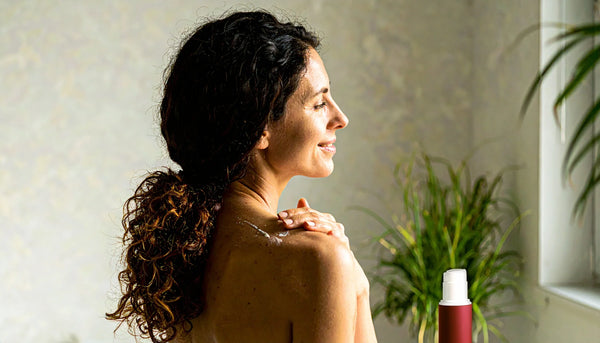Vitamin E—most often listed on skincare labels as tocopherol or tocopheryl acetate—is widely called the “skin defender” for a reason. It’s a fat-soluble antioxidant that sits comfortably within skin’s lipid layers, where it helps neutralize free radicals from UV exposure and pollution before they can trigger oxidation, irritation, and premature lines. Unlike fleeting trends, Vitamin E has decades of use in dermatology and cosmetic science; it’s valued not only for its protective activity but also for its emollient feel, barrier support, and compatibility with many routines. Because it’s oil-loving, it integrates into formulas to make them feel cushioned and helps stabilize other delicate ingredients that would otherwise degrade when exposed to light or air.
What It Is (and the Forms You’ll See)
“Vitamin E” is an umbrella term for a family of molecules. In skincare you’ll most often see tocopherol—the biologically active form that skin can use immediately—and tocopheryl acetate, an esterified (more stable) version that’s converted to tocopherol on the skin. There are also tocotrienols, which share antioxidant properties and appear in some advanced formulas, though they are less common. Pure tocopherol can be more potent but also more prone to oxidation if packaging and formulation aren’t right. That’s why you’ll frequently find Vitamin E paired with other antioxidants (like Vitamin C and ferulic acid) or included in airless pumps and opaque bottles to protect its activity. Concentrations vary widely—anywhere from ~0.1–1% in antioxidant serums up to a few percent in richer creams and oils—because Vitamin E is doing double duty as both an active and a sensorial emollient.
How Vitamin E Protects (and Why Your Skin Notices)
At the cellular level, Vitamin E helps interrupt lipid peroxidation—the process where free radicals damage the fatty components of cell membranes and the skin barrier. Left unchecked, that damage shows up as dullness, tightness, and an “easily irritated” complexion. Tocopherol places itself in the outer layers of the skin, where it can donate an electron to neutralize reactive oxygen species and then be “recycled” back to its active form by other antioxidants (notably Vitamin C). In practical terms, this can translate to a calmer feel after daily exposure to sun and city life, enhanced comfort in dry or wind-stressed climates, and a subtle boost to the look of smoothness and resiliency. While Vitamin E is not a sunscreen and shouldn’t replace SPF, it’s an excellent supporting player in a photoprotection strategy because it helps limit the downstream oxidative stress that persists even with good sunscreen habits.
Key Benefits You Can Expect
First, barrier support: Vitamin E’s oil-soluble nature helps reinforce the moisture barrier, reducing transepidermal water loss so skin feels less tight and more supple. Second, soothing comfort: by moderating oxidative stress, tocopherol can help reduce the look of redness from everyday aggressors and make actives-focused routines (retinoids, AHAs) feel more tolerable when layered smartly. Third, formula stability: formulators add Vitamin E to help protect oils from going rancid and to keep other antioxidants from degrading too quickly; the side effect is often a silkier, more elegant texture. Finally, cosmetic payoff: many users notice an immediate “cushioned” finish that plays nicely under makeup, while long-term use supports a more even, resilient look. For minimal routines, combining a hydrating step with a cream that includes Vitamin E is an effective way to get both comfort and defense without clutter.
How to Use It (Pairings, Layers, and Packaging)
Vitamin E is versatile. In the morning, it pairs beautifully with Vitamin C serums (C helps recycle E) and should always be followed by a broad-spectrum SPF. At night, it layers well over gentle exfoliants or retinoids to restore comfort. Look for airless or opaque packaging to minimize air and light exposure; if you’re using a facial oil with added tocopherol, close the cap tightly and store it away from heat to slow oxidation. If your skin is dry or seasonally stressed, richer creams with tocopherol can provide immediate relief; if you’re combination-oily, a lighter serum-cream pairing may be more pleasant. Typical usage is once or twice daily, depending on your routine and how your skin feels. If you’re integrating Vitamin E via a product you already love—say a daily cream—there’s no need to add a separate tocopherol drop unless you enjoy the texture; the goal is consistent, sustainable use.
Keep it simple and repeatable. Vitamin E (tocopherol) layers well with daily hydration in the morning and comfort care at night. The goal: calm, cushion, consistency—without crowding your shelf.
- AM: Cleanse gently → apply a hydrating serum → layer a daily cream that includes or complements antioxidants. Finish with broad-spectrum SPF.
- PM: Remove make-up/sunscreen without stripping → apply your treatment (if used) → seal with a barrier-friendly cream.
Non-claim suggestions from the Suvéra range: after cleansing with our All-In-One Facing Oil, hydrate and finish with our Silk Skin Hand Cream, Spices & Sandalwood for a soft, comfortable finish. If you’re breakout-prone, choose lighter textures and patch-test.
Note: This is general information, not medical advice. Avoid if you’ve reacted to tocopherol before, and check ingredient lists if you have specific allergies.
Who Should Be Cautious or Avoid It
Although Vitamin E is broadly well-tolerated, there are important caveats. Very acne-prone or oil-rich skin types can sometimes find heavier Vitamin E–rich oils or balms too occlusive, which may exacerbate clogged pores; in that case, opt for lighter emulsions that include tocopherol without an oily afterfeel, and patch-test before daily use. A small number of people experience contact dermatitis from tocopherol—if you’ve reacted to Vitamin E–heavy products before, avoid leave-on formulas and consult a professional. Those with a known soy allergy should check sourcing notes; many forms of tocopherol are derived from soy or sunflower (purification typically removes proteins, but caution is wise). For fresh, healing wounds or new scars, evidence is mixed; applying Vitamin E early can sometimes delay healing or cause irritation in sensitive individuals, so wait until the area is fully epithelialized and follow your clinician’s advice. During pregnancy or breastfeeding, topical Vitamin E is generally considered low-risk when used as directed, but it’s always sensible to review your routine with your healthcare provider. Finally, remember that rancid or old oils (a sharp, “paint-like” smell) indicate oxidation—discontinue use and replace the product.
Bottom Line
Vitamin E earns its “skin defender” status by protecting lipids from oxidative stress, cushioning the barrier, and enhancing the elegance and stability of modern formulas. It shines in minimalist routines that prioritize comfort, resilience, and repeatable results—especially when paired with Vitamin C by day and barrier-friendly moisturizers at night. If you’re breakout-prone or have a history of sensitivities, choose lighter textures, patch-test first, and respect packaging and shelf life. Used thoughtfully, tocopherol is one of the simplest, most reliable ways to help skin look calmer, feel softer, and stand up to daily life.





